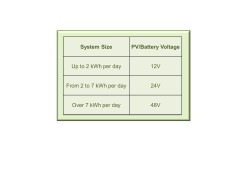Eliminate Tree Shading
You will want to shade your house's south side from the summer sun, but not your PV array. Even partial shading can cause a disproportionate loss in electrical energy. Trees should be maintained to prevent obstruction, especially between 9 a.m. and 3 p.m. (the prime sunlight hours).
Consider Snow And Ice Buildup In Winter
Consider ice and snow buildup if your region suffers harsh winters. PV panels face more vertically during winter and so can end up covered in lots of snow and ice. It may take days for powdery snow to fall off your array on its own, but you do not want to risk damage with harsh brushing, especially on roof-mounted panels. Wipe snow away with a wet sponge and leave the ice to melt on its own – do not try to break it yourself.
Ensure That Modules Do Not Overheat In Hot Weather
The electrical output of a PV module decreases as temperatures rise. For peak operation, seat modules with a 2-3 inch (5-8 cm) gap under the array for cooling air to circulate and maintain maximum power output.
Decide System Voltage
Off-grid systems usually adopt one of three common system voltages: 12V, 24V or 48V. You may choose your preferred voltage and power levels but most people use the following chart:
The PV industry adopts standardized 12V or 24V modules for nominal output. You can connect PV modules in parallel for increased current as well as increased system wattage with no panel voltage change. It is better to have a series and parallel mix where two (series) rows of four (parallel) PV panels can increase the voltage of the system, with each PV module connected like batteries in series, positive connectors to negative connectors. With four 12V panels connected in parallel, the voltage increases by four, giving a 48V array. Two rows of PV panels of similar connection give the same total system voltage.
Locate The Array As Close To The Batteries As Possible
Have you ever wondered why two or three connected garden hoses cause a sprinkler to dribble even though the house's water pressure is fine? This is the flow resistance phenomenon. Electrical circuits experience the same phenomenon: electrical flow resistance. Circuits with low voltage (or pressure) need big wires to pass the current. A PV array which is further from a battery or inverter will lose more electrical energy. You can increase the voltage to counter the loss but distance can impact low direct current power generation. It's better to minimize the wiring distance and maximize the wire size to reduce power loss to a minimum.
Incidentally, this is the primary reason the North American electrical grid transmits very high voltages (up to 750,000V in some areas). Even at that voltage, there are electrical losses. Ontario province has a transmission grid of about 15,000 miles (24,000 km) with electrical loss that is equivalent to three large nuclear reactors' energy output! Distributed off-grid PV systems or grid-interconnected PV systems put power generation and consumption components close to each other in order to lower, if
